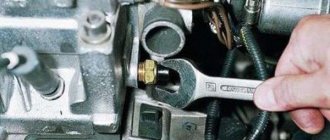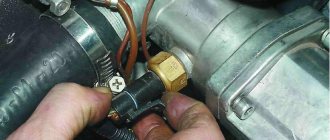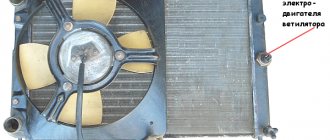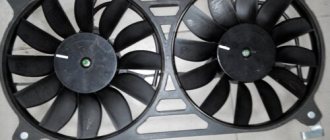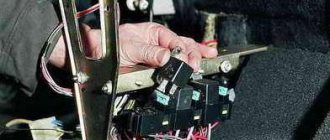Hi all! Summer is approaching and I noticed that they are boiling, overheating, etc. I don’t like that in hot weather when driving not fast, the temperature of the engine coolant on the dashboard rises close to the red zone, after which the cooling system fan starts and the arrow falls down. And so back and forth. In general, for a VAZ 2110 such spasmodic behavior of the needle is considered normal.
Of course, the dashboard may be lying here and according to the On-Board Computer the readings are completely different. But still the effect is unpleasant and always alarming. I would like to somehow make the temperature control smooth and not abrupt. So that the temperature is maintained at the same level all the time due to different rotation speeds of the Carlson or by turning on the fan earlier.
And then the idea occurred to me to make, like many others, a forced button to turn on the fan. After looking on the Internet how this is done, I got to work.
And so, what we need: 1. Copper wire with a cross-section of 1.5-2 mm. (I have a wire about half a meter long) 2. Button (I took the air circulation button.) 3. 2 terminals (male, female) 4. Electrical tape.
First of all, disconnect the “-” terminal from the battery. Next, we unscrew the cover, which is attached to two or three self-tapping screws, remove the cover and see three relays there.
We need a relay
fan,
Relay: 1 – electric fan relay; 2 – electric fuel pump relay; 3 – main relay (ignition relay).
ATTENTION! I have the order of the relays from the factory. The order of relays and fuses can be arbitrary, we focus on the color of the wires.
Next, we take the wire and connect contacts 30 and 87 on the fan relay, no matter which wire goes where, the contact numbers are on the relay itself. I have an upper and lower entrance. And we lead the wire to the place where you want to connect the button.
I got it like this:
fan switch button for VAZ 2110
I connected the battery, turned on the button, it works like a clock!
In addition, I made a video.
Thank you all, this is temporary for me and then I will connect it through an additional relay.
Everything is simple and clear, I think you won’t have any questions when connecting, the main thing is not to be lazy and everything will work out for you!
Many people have noticed that the temperature at which the radiator fan on a VAZ turns on is too high when compared with the operating temperature of the engine. Manufacturers are trying to reduce the amount of harmful emissions, since at high temperatures the fuel burns better together with the components.
But there is not only a positive effect, but also a negative one. If the engine overheats a little, then destructive processes begin for the metal inside, so wear resistance decreases. If you do not take into account that electrical components that affect the switched on fan may fail, then the time to notice overheating will be less than at normal temperatures.
We need to ensure that the engine operates evenly. This can be accomplished by creating a parallel fan circuit. A positive wire must be connected to one contact, and the negative contact is connected to the switch via a parallel wire.
It is worth mentioning additional features that allow you to control the normal engine temperature. There are no relays in the electrical circuit as a simple switch is sufficient for operation.
This method is not a replacement for the standard fan operation circuit, but only an alternative option for operating the unit at low temperatures. The driver must control the entire process.
If the car’s engine overheats, but this connection diagram is implemented, then it is better to check the cooling system again, ensuring its operation.
As soon as signs of overheating are detected, that is, the arrow indicating the temperature has entered the red zone, but there is still no puff of steam from the engine compartment, then turn on the interior heater at full power.
This will help reduce the temperature of the coolant in the cooling system. Next you need to turn on the emergency lights, depress the clutch pedal and roll to the side of the road. The car cannot be turned off immediately; the engine is run at normal idle speed for about five minutes, and the heater must still operate at full power. Only now can you open the hood and inspect the engine compartment.
You need to try to determine where the steam is coming from, see if there is coolant in the expansion tank, check the integrity of the thermostat, radiator and rubber hoses.
And so hello everyone. In Volgograd, the heat is terrible, the temperature in the shade is 40 degrees, and in the sun it’s probably 50 degrees, my engine cooling system can’t cope with such climatic conditions, even at speed the temperature doesn’t drop below 90, and in a traffic jam it actually reached almost 120. Start The fan of the engine cooling system (VSOD) is programmed at 105-107 degrees, shuts down somewhere around 100, constant on and off periodically begins to wear on. In connection with this, it was decided to modify the cooling system. There are many options for improvement: 1. Smooth start of the coolant fan 2. Use SILICH-BOREY 3. Start regulator for the RPV fan of LADA cars 4. Turn on the radiator fan (Carlson) from the button. I won’t describe each method, I chose 4 from the button, and I’ll tell you about it. And so we need:
1.relay 4-pin
2. block to the relay (optional)
3. resistance (resistor) of the heater VAZ 2110 3-pin
5. Terminals mother + father (10 pieces)
6.recirculation button VAZ 2110
And so everything is ready, we can start. We will use this circuit: The circuit is simple: in parallel with the standard fan relay Rv, an additional relay Rv2 is connected, manually controlled by the button Sv2. When relay Rb2 is turned on, the fan is connected to ground through resistance Rb2, which ensures slow rotation. The standard circuit operates as before; upon a signal from the controller, the fan turns on at full speed.
We are looking for a thin pink-black wire coming from the main relay (pin 85*) and a thick power white-black wire (pin 87) and connect our relay to them. * according to the book, on different VAZ models of the 10th family, the pink-black wire of the main relay can come to both pin 86 and 85. We focus on the color of the wires. We do not touch the black-purple (black-red) thin wire coming from the controller.
Circuit diagram for switching on the cooling fan for a VAZ 2110 carburetor engine.
The circuit diagram for switching on the cooling fan of the VAZ 2110 on carburetor and injection cars is different. On cars with a carburetor engine, a thermobimetallic sensor TM-108 is used for this, and on cars with an injection engine, control is carried out by a controller.
When the fan is controlled by a sensor, the switching temperature depends on the sensor setting temperature, which is indicated on the housing. If the fan does not turn on when the temperature rises to the sensor response temperature, you must first check the serviceability of the sensor. To check, just close the contacts on the sensor and if it turns on, you need to change the sensor. If after closing the terminals the fan does not work, then the cooling fan switching circuit and the integrity of the fuse need to be checked.
When does the radiator fan turn on on a VAZ-2110
To really understand how to change the fan switching temperature on a VAZ-2110 injector, you need to know exactly the factory design parameters and the principle of fan switching itself.
In carburetor engines, the fan turned on at about 100 degrees.
On old-style 2110 carburetor engines, the fan was turned on using a thermobimetallic sensor. It was installed directly in the radiator bank and set to a certain temperature. Since the normal operating temperature of antifreeze is 80-90 degrees , the bimetallic plate made contacts at approximately 100-105 degrees .
In a carburetor VAZ-2110, the sensor is located in the radiator.
In an injection engine, the sensor is located in the cylinder block.
In injection tens, the fan starts in a completely different way. There are two temperature sensors installed near the thermostat - one with one wire, the second with two. The first one is responsible only for the temperature indicator needle, so there is little demand from it. The second sensor with two wires is working. It is he who supplies the impulse to the electronic engine control unit, which then supplies power to the fan motor network.
Scheme.
Features of the temperature sensor
However, one must understand that a temperature sensor is a conventional converter of thermal energy into a variable electrical pulse. More precisely, when the temperature of the antifreeze changes, the resistance of the sensor changes approximately in this mode:
| Antifreeze temperature, °C | Resistance, Ohm |
| 100 | 123 |
| 80 | 215 |
| 60 | 667 |
| 40 | 1459 |
| 20 | 3520 |
| 0 | 9420 |
| -20 | 28680 |
| -40 | 100700 |
Now the principle of operation of the fan activation system becomes clear - the ECU receives a certain electrical impulse when the temperature reaches 110 ° C (133 Ohms) and supplies power to the fan motor.
As soon as the resistance of the sensor element rises to 187 Ohms (which corresponds to 97 °C), power is removed from the fan and the engine cools down.
The fan does not turn on.
But there are malfunctions in which the controller does not recognize the malfunction and the fan may not turn on when the temperature reaches above 105 degrees. C. In this case, to check the circuit and sensor, it is necessary to remove the connector from the temperature sensor while the engine is running. If the circuit is working properly and the sensor is malfunctioning, the fan will turn on and turn off when the connector is returned to its place.
If the circuit malfunctions, it is necessary to check the integrity of the fuse, the serviceability of the relay and wires, according to the circuit. For a quick check, you need to bridge terminals 30 and 87 of the fan relay, located in the heater shaft on the passenger side. If the fan works, without removing the relay from the block, connect the case and pin 86 of the relay with a test lamp, the relay should work and the fan should turn on. In this case, the controller or the wire connecting the relay to pin 46 of the controller is faulty.
If you do not hear the characteristic click of the relay turning on, and a positive signal is supplied from the main relay to pin 85 of the relay, and if there is a click and the fan does not turn on, change the relay. When installing a jumper between pins 30 and 87 does not turn on the fan, check the integrity of the fuse and the presence of power at the fan terminals. If there is power on one terminal and no power on the other, this indicates a possible malfunction of the fan motor.
Scheme for switching on the cooling fan of an injection engine.
- Connection diagram for a fan with a timer: operating principle and connection order
06/09/2011 “If you notice an error in the text, please highlight this place with the mouse and press CTRL+ENTER” “If the article was useful to you, share the link to it on social networks”
To ensure safe and stable thermal conditions of an internal combustion engine, precise operation of the cooling system is required. The slightest failure will lead to overheating of the engine, which can lead to burnout of the head gasket or failure of the piston group elements.
The radiator fan is one of the key components of the car cooling system. Its role is to promptly force cool the liquid in the radiator. Problems with turning it on are a common occurrence for our cars.
In this article we will talk about possible reasons why the VAZ-2110 cooling fan does not work, and also consider options for eliminating them. But first, let's understand its design and operating principle.
Reasons for cooling fan failure
The occurrence of malfunctions in the 2114 car is common, especially when using the car every day. Problems with the cooling system occur in every third car. It is impossible to allow the motor to constantly overheat due to the fan not working. There are several reasons for airflow failure:
- Broken wiring in the motor connection circuit;
- Malfunction of the relay responsible for turning on the electric motor;
- Burnt fuse in the mounting block;
- Destruction of mechanical elements in the motor housing. Wear of the winding, destruction of the housing, moisture getting inside - all this leads to failure;
- Problem with contacts or wire blocks. Oxidation or breakage of wires at the connection point is a common situation.
You should always start checking the causes of a breakdown by connecting the electric motor directly. Next is to check the pre and relay. If the reason is not found, “dig” towards the wiring.
Fuse F5 20 Ampere
Frequent blowing occurs in the warm season, while in winter the device practically does not turn on. During movement through mud and puddles, the contacts on the motor body may oxidize. It is recommended to check the condition of this system before the onset of warm weather.
Fan connection diagram in carburetor and injection engines
The control of forced radiator airflow in carburetor and injection engines of the VAZ-2110 is significantly different. Firstly, the fan switch located on the radiator housing is responsible for everything. It is set to a certain coolant temperature. Usually it is 105-107 oC. When the coolant heats up to this temperature, the sensor is triggered, sending a signal to the fan relay. It closes the electrical circuit, driving the electric motor.
- Scheme for switching on the cooling fan VAZ 2107 carburetor
Turning on the cooling fan of a VAZ-2110 with an injection engine occurs somewhat differently. In engines equipped with an electronic control unit, there is no sensor on the radiator. Its place was taken by a temperature sensor located on the thermostat pipe. When the coolant heats up to a temperature of 105-107 oC, it sends a signal directly to the controller, which makes the decision to turn on the fan. It transmits an electrical impulse to a relay, which turns on the electric drive.
Design and testing of the VAZ 2110 fan switch sensor
To maintain optimal temperature conditions of the car engine, a cooling system is designed. Its main elements are channels for antifreeze in the cylinder block, pipes, a thermostat, a radiator, and the electrical part includes a VAZ 2110 fan switch sensor, a temperature sensor and an electric motor with an impeller for cooling the radiator. Late detection of cooling system defects can lead to engine overheating and costly repairs.
Fan switch sensor LS 0108 (TM-108)
Possible faults
If the VAZ-2110 cooling fan does not work, do not rush to contact a car service center. You can determine the cause of the malfunction yourself. Moreover, it is not at all necessary to have special skills for this.
The cooling system fan may not turn on due to:
- electric drive malfunctions;
- blown fuse;
- faulty thermostat;
- a failed fan switch (temperature);
- faulty relay;
- broken electrical wiring;
- faulty expansion tank plug.
How to change the temperature?
Over time, more and more complaints appear about the operation of the cooling fan activation system. The most important design flaw is the lack of several fan operating modes and the abrupt start of its motor . Indeed, in the summer heat the fan has to work at full strength, and this is understandable. However, most often the fan produces excessive performance, which leads to rapid cooling and frequent starts.
This leads to a current overload on the on-board network.
In addition, the starting temperature threshold is too high, so the engine often overheats . Unfortunately, you can only change the fan startup parameters by reflashing the electronic control unit or upgrading the electric motor activation system. Reflashing the ECU is carried out by a competent specialist, and it is possible to set any desired temperature for turning the fan on and off.
Basic methods
Diagram for connecting an additional fan sensor.
There are also several solutions to changing the operating modes of the fan motor. The simplest of them is to install an additional switching sensor from carburetor engines (in the diagram above). It is configured to turn on at a temperature of 97-100 ° C , which will be quite enough. And in order for the fan to operate in this mode at half power, a resistance from the VAZ heater is installed in the circuit.
Sensor.
Tee "Gazelle".
Additional resistor from UAZ.
Thus, the upgraded fan will have several advantages:
- The fan switch-on temperature is below standard.
- Two operating modes - ½ and full power.
- Less noisy fan operation.
- Less starting load on the on-board network.
- More flexible temperature regime of engine operation.
- The normal mode of turning on the fan is maintained.
Inserting a tee into the section of the upper pipe.
Installing a resistor on the fan housing.
In this way, it is possible to modify the control system for the electric cooling radiator fan of the VAZ-2110. Stable temperatures to everyone and good roads!
How to check the thermostat
The function of the thermostat in an internal combustion engine is to regulate the flow of coolant, directing it in either a small or large circle. While the engine is cold, its valve blocks the flow of coolant into the cooling radiator. This allows the engine to warm up faster.
When the coolant warms up, the thermostat valve opens, directing it to the radiator for cooling. If the valve jams, the coolant constantly moves in a small circle, not reaching either the fan switch sensor or the temperature sensor. In this case, the liquid may even boil, but the sensors, being uninvolved in such a circuit, will not work.
Check the thermostat by determining the temperature of its pipes by touch. When the engine is warm, they should all be hot. If the pipe leading from the thermostat to the cooling radiator is cold, the locking device is faulty.
- Installation on VAZ 2108 and 2109 with a low torpedo instrument cluster from 2115
How to check the sensor
One of the most common reasons why the VAZ-2110 cooling fan does not turn on is a non-working sensor for its activation (for carburetor engines) or a temperature sensor (for injection engines). Let's consider ways to check them for different engines.
In a car with a carburetor engine, you must turn on the ignition and short-circuit the two wires going to the sensor. The fan should turn on. If this does not happen, the problem is definitely not with the sensor.
For injection cars, it is necessary to warm up the engine to operating temperature and disconnect the sensor connector, disconnecting it from the vehicle’s on-board network. In this case, the controller must start the fan in emergency mode. The electronic unit perceives this as a failure in the cooling system and forces the fan drive to operate in constant mode. If the drive starts, the sensor is faulty.
How to check the cooling fan on a VAZ 2114?
There are several ways to check whether the fan is working on a VAZ 2114. First, it’s worth determining whether the main structural element – the electric motor – is working. Due to the convenient location of the motor, you can easily get to its contacts. If you have wires, you can connect the motor directly to the battery. If the motor starts working, the cause of the breakdown is clearly not in it.
In the photo above, the chip with the wire is clearly visible. This chip has a plug. The test should be done by connecting two wires directly to the battery. Often the cause of malfunction and failure of the electric motor is the temperature sensor. The host computer protection system in 2114 is such that when this sensor is turned off, the fan must operate in emergency mode. It is enough to warm up the car to operating temperature, and then turn off the sensor. At this moment, the controller determines the absence of a sensor as a malfunction and turns on the fan in emergency mode. This element can be changed without any problems.
Having removed the chip from the sensor connector, do not forget to put it back in place after checking the functionality of the blower.
Useful : The engine on the VAZ 2114 gets hot (5 reasons)
Checking the cooling fan relay
The most difficult step in troubleshooting a fan is determining the functionality of its relay. It is only relatively possible to establish its serviceability at home. But you also need to know where the cooling fan relay is located.
And it is located in the additional mounting block of the center console. On the lower left side of the front passenger side there is a plastic cover covering the console. To open it, you need to unscrew four screws. There are three relays under the cover. The leftmost one is responsible for turning on the cooling fan. You can check it only by installing a known-good device in its place. After the engine has warmed up to the sensor response temperature, wait for a characteristic click. If the cooling fan relay does not work, you need to check the wiring.
How to check wiring
Finding a broken conductor in a car's electrical circuit yourself is not at all difficult. It is necessary to check (ring) all wires in the indicated areas with a tester.
For carburetor engines:
- from the switch on sensor to the fan;
- from the fan to the mounting block (fuse);
- from the mounting block to the relay.
For injection engines:
- from the main relay to the fan switch relay;
- from the switching relay to the fan and controller;
- from temperature sensor to controller;
- from the fan to the mounting block (fuse).
If a wiring break is detected, it must be restored, as well as the possible cause of the circuit break must be identified and eliminated.
Expansion tank cap
The last reason why the VAZ-2110 cooling fan does not work may be a malfunction of the expansion tank cap. The fact is that when the engine is running, a pressure above atmospheric pressure is created in the cooling system, due to which the water, which is part of the coolant, does not boil at 100 ° C. The expansion tank cap valve is designed to maintain the required pressure. If it fails, the pressure in the system will be equal to atmospheric pressure. This will cause the coolant to begin to boil already at 100 degrees. A sensor designed to turn on at a higher temperature will naturally not work.
It is unlikely that you will be able to check the operation of the cover at home, so if during a visual inspection you have doubts about its functionality, it is better to replace it immediately.
Forced activation of the fan VAZ 2110 VAZ 2111 VAZ 2112
Most likely, you have noticed that the temperature at which the VAZ 2111 radiator fan turns on is too high compared to the operating temperature of the engine. In this way, the manufacturer tries to reduce the amount of harmful emissions through the exhaust pipe, since at high temperatures more complete combustion of fuel and its components occurs.
However, in addition to the positive effect, there is also a negative point. The fact is that even with a slight overheating of the engine and cylinder head, physical and chemical processes that are destructive to the metal begin to occur inside, thereby reducing its wear resistance. Apart from the fact that in the event of a failure of the electrical components that influence the fan’s activation, the time to notice this at an elevated temperature of the normal switching on of 105 C to overheating of 125 C will be significantly less than from normal operating temperature to overheating. Our goal is to achieve uniform and controlled operation of the VAZ 2111 power unit. This will be accomplished by creating a parallel fan circuit. A positive wire is connected to one of the fan contacts; as for the negative contact, a connection will be made here through a parallel wire with a switch. It wouldn’t hurt to mention additional options for monitoring normal engine temperature. There is no relay in this electrical circuit; for its operation, a powerful switch is sufficient, which is designed for a current of more than 20 amperes at 12 volts. Attention, this method is not a replacement for the standard circuit for triggering the radiator fan in the car; it is an alternative option for operating the power unit at low temperatures and is controlled by the driver. If the engine of a VAZ 2111 car overheats and you have implemented this connection diagram, it is still worth checking the cooling system once again and ensuring its functionality.
As soon as you have identified signs of overheating, that is, the temperature gauge needle has gone beyond the red zone, but no clouds of steam have yet emerged from the engine compartment, turn on the interior heater at full power. This will reduce the temperature of the coolant in the cooling system. We turn on the emergency lights, depress the clutch pedal and roll to the side of the road. Do not turn off the car immediately; the engine should run for five minutes at normal idle speed, the heater should still be running at full power. Now open the hood and inspect the engine compartment. As soon as you turn off the engine, local overheating of the coolant begins in some areas. After a couple of minutes, it is advisable to start the engine again for about 10 seconds, thereby preventing the new volume of coolant from coming into contact with engine parts. Try to determine where exactly the steam is coming from, see if there is coolant in the expansion tank, check the integrity of the rubber hoses, radiator and thermostat. Now we go into the cabin and look under the instrument panel on the front passenger side and make sure that there is no fluid leakage there. If a system hose bursts, it can be temporarily restored by gluing adhesive tape.
The principle of operation of the cooling system of the VAZ 2110 injector 16 valves
The design is a closed circuit, inside which coolant is pumped through a centrifugal pump. The radiator releases the temperature generated by the engine into the atmosphere. The sensor installed on the thermostat pipe senses the coolant heating threshold of 105 - 107 degrees Celsius, provides information to the controller. The controller sends a signal to the relay, starting the electric motor of the fan. The radiator honeycombs are blown.
The principle of operation of the cooling system of the VAZ 2110 injector 16 valves: 1 - heater radiator; 2 — coolant drain hose from the heater radiator; 3 — coolant supply hose to the heater radiator; 4 — coolant pump hose; 5 — expansion tank hose; 6 — steam removal hose of the heater radiator; 7 — expansion tank cap; 8 — expansion tank; 9 — thermostat; 10 — coolant drain hose from the engine radiator; 11 — hose for supplying fluid to the throttle assembly; 12 — steam exhaust hose of the engine radiator; 13 — hose for supplying fluid to the engine radiator; 14 — engine radiator; 15 — radiator drain plug; 16 — electric engine radiator fan; 17 — coolant pump; 18 — supply pipe of the coolant pump; 19 — coolant drain hose from the throttle body.
Safety regulations
- Open the expansion tank cap after the engine has cooled down.
- When working under the hood, beware of rotating blades and a hot engine.
- Use auxiliary, serviceable conductors with a cross-section of 2 mm.
- Use standard fuses of the required rating.
- Use a proper tool.
- Insulate “bare” contacts, avoiding short circuits in the electrical wiring.
Possible cooling fan malfunctions
There are seven known reasons why the fan on a VAZ 2110 does not turn on.
- The safety valve of the tank is stuck and not sealed.
- The integrity of the conductors is broken, there is poor contact at the connection points of the circuit elements.
- The fuse link on the control panel has burned out, there is no contact in the fuse sockets.
- The temperature sensor is faulty.
- The relay for turning on the electric fan drive is damaged.
- The fan motor has burnt out.
- The controller is faulty.
Procedure. Step-by-step instruction
If after completing the next step the problem goes away, further checks are stopped.
- Open the hood.
- Wait for the engine to cool down.
- Make sure that the expander cover elements are in good condition. Remove scale, rust, clear holes, wipe, assemble. The absence of noticeable damage to parts gives hope that the product will work.
Inspect the electrical wiring elements to ensure a reliable connection
Possible factors for damage to electrical circuits:
- vibration;
- oxidation;
- burning;
- breakage, fraying of electrical wires;
- insulation aging, short circuit.
Switch the tester to resistance measurement mode. Remove it with special tweezers and ring the fuse link F7 located in the mounting block.
Fuse box diagram
Attention! It is important to find out and eliminate the cause of burnout.
Replace the burnt-out element with a serviceable one with a rating of 20A. Inspect and clean the nest. Insert fuse.
It was not possible to find out the reason, the protection triggered again - look for a short circuit.
How does the engine cooling system work? Diagram
Disconnect the fan plug. Use a tester to measure the circuit of the electric motor windings. Zero resistance or a break indicate the need to replace the radiator blower electric drive.
Interturn short circuits that cause multiple replacements of fuse links cannot be measured with the device.
Sensor check
Start the car. Pull out the coolant temperature sensor connector. The fan starts working - the sensor needs to be replaced. Secure the disconnected wire. Drive to a nearby service station.
Relay test
There is a hatch on the floor at the front passenger's feet.
Below it is a built-in panel with three relays of the same type:
- fan installation;
- fuel pump;
- ignition (main thing).
By replacing each other, try to start the airflow. The VAZ 2110 fan does not work - go to the next step.
Where is the VAZ 2110 cooling fan relay located?
If you are wondering where the fan relay is located on a VAZ 2110, then this photo below will answer your question and you can easily find where the cooling fan relay is located on a VAZ 2110.
VAZ 2110 fan relay
Check the electric motor
- The only correct solution is to turn on the airflow directly and urgently visit a service station.
- Prevention of breakdowns of the cooling system of the VAZ 2110 injector 16 valves.
- Periodically inspect the components of the cooling system.
- Monitor the cooling temperature on the device, listen to the operation of the fan.
- Maintain coolant level. Replace after 2 years or 30,000 km.
- Use the solution to remove rust and scale.
- Signs of a change in the properties of the coolant are a change in color, an increase in fluidity.
- Check the density with a hydrometer.
- Do not mix coolants.
- Every twelve months, rinse the expansion tank cap with water and check it on a stand with a pressure gauge.
- Avoid contact of aggressive liquids with electrical wiring and electric motor windings.
